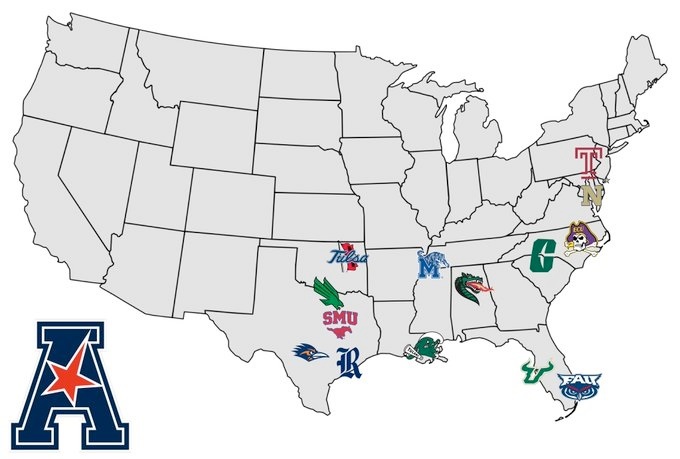Follow Alamo Audible:
UTSA reached another major benchmark in the university’s rapid ascension as campus leadership announced their intention to join the American Athletic Conference last week. Just 11 seasons into its existence as a football-sponsoring athletics program, UTSA has gone from the Southland to FCS Independence, to the WAC, Conference USA, and now, the best Group of 5 conference in America, all within a relative blink of the eye.
This type of rapid upward trajectory is mostly unparalleled in college football. The USF Bulls joined the Big East (a BCS automatic qualifier at the time) after just eight years of football, but most other start ups spent several decades building their programs up before getting a major promotion like this.
While the increase in conference revenue, broadcast exposure (both linear and streaming), and competition will certainly provide UTSA athletics with a major boost, it also presents many challenges for the Roadrunners’ leadership to face head on.
UTSA will be competitive with the majority of the conference on the football field and in the recruiting realm on day one, but the Roadrunners lag sorely behind their newfound conference mates in operating expenses and facilities. The Roadrunners had finally started to find their footing in Conference USA in terms of budget and competition, but now UTSA will be forced to leap off a taller diving board as they head to a stronger conference.
Funding and facilities present a problem
With UTSA reportedly looking at a $35 million athletics budget in the 2021-2022 school year, the Roadrunners will need to raise their spending by roughly 15% to no longer by a negative outlier in the AAC as far as spending goes, while an increase of 50% would put UTSA on competitive footing with the majority of the conference.
Could UTSA look to a student vote to increase their athletic fees as a potential solution? It wouldn’t be an ideal answer, but based off the student section crowds in the Alamodome, it may be time to strike while the iron is hot. With an exploding enrollment, even a modest increase could add millions to UTSA’s budget as the downtown campus begins to expand.
Outside of the recently-opened RACE facility, every single one of UTSA’s athletics facilities are embarrassingly unfitting for an AAC program. Without a surplus of mega-donors, UTSA will likely need to resort to mortgage financing and public bond access to bring their facilities up to a reasonable level. While taking on debt is never preferable to having boosters shoulder the burden, UTSA should follow the trail blazed by Arkansas State and UCF, among others, in utilizing record-low interest rates to begin facility construction immediately.
As you may recall, UTSA used a combination of philanthropic contributions, public bond money, and financing from the Roadrunner Foundation to fund the construction of the Roadrunner Athletics Center for Excellence facility. UTSA athletics is currently leasing the RACE from the Roadrunner Foundation while they service a $1 million payment for the following 25 years. With UTSA’s conference TV payout increasing from ~ $450k to ~$2m (among other increasing revenues), this debt leverage has already paid for itself many times over with the move to the American.
While financing facility improvements appear to be a solid investment thus far, UTSA needs to avoid a scenario where their operational budget matches their new conference peers, but only thanks to debt service payments. Coaching salaries need to rise, recruiting budgets must go up, and administration head count also needs to increase for UTSA to have a Power 6-worthy athletics program across all sports.

Regionalization will help the bottom line and fan engagement
Complications aside, there’s no denying that UTSA is in a perfect conference affiliation set up.
The move to the AAC further regionalizes UTSA’s division, as UTSA will have an average mileage of 419 miles to its assumed divisional foes in olympic sports (Wichita St., Tulsa, UNT, SMU, Rice, Tulane), as opposed to 500 miles in C-USA West (UTEP, UNT, Rice, USM, UAB, La Tech). Even when adding a new record trek to Philadelphia, UTSA still comes out ahead in conference average mileage, dropping from 906 in C-USA to 851 in the AAC.
More importantly than the reduction in miles to cover, travel expenses should also drop pretty considerably by adding another bus-able opponent and by being able to reach practically every conference member by an easy commercial flight. When UTSA goes to play Southern Mississippi today they have to fly to New Orleans or Jackson then charter a bus or van to drive two hours to the university. While Marshall does technically have an airport in Huntington, it’s hard to get the tennis team there in a financially prudent manner. Getting a team to Ruston requires a really long bus ride or a flight and a chartered van or bus.
East Carolina is the only AAC member which would present such travel difficulties for UTSA. The Roadrunners will also likely be able to avoid over-night hotel stays for many of their trips in their new conference home as more commercial flight options will be open for them to schedule around their competition commitments.
From a rivalry development standpoint, sharing a division with three other Texas teams and two teams in bordering states certainly can’t hurt. I’m surprised more Texas-based college football writers haven’t dubbed this western division of AAC a modern version of the Southwest Conference.
The brand recognition of SMU, Tulane, Memphis, and Navy surely surpasses that of Southern Miss, Old Dominion, and Florida International as far as casual San Antonio sports fans are concerned. The basketball credentials Wichita State, Memphis, and Temple bring to UTSA’s schedule is almost unbelievable, while the conference is also shaping up to be an upgrade in baseball.
Moving to 14 football members as opposed to 12 didn’t sit right with me as far as expansion strategy is concerned, but it could benefit UTSA, and the conference, greatly. From a conference perspective, the move practically pulverized Conference USA into dust, while simultaneously removing any realistic expansion candidates for the Mountain West. If Boise State were to join the Big 12 then the MWC may have no choice but to promote FCS programs, of which there are few west of the Rio Grande.
On the UTSA side of the equation, the Roadrunners will not only reduce their travel costs, but they will also have company as they attempt to grow their athletics program as North Texas, Rice, and Charlotte seek to find their footing in football, while UTSA and FAU work to figure things out in basketball. However, there are still aspirational programs for UTSA to strive to surpass in the conference pecking order such as SMU and Memphis.
When UTSA first joined Conference USA the program had its sights set on surpassing Rice and Louisiana Tech. Based off the past two weeks, I think it’s safe to say that mission has been accomplished. If we could fast forward eight years from now and say the same thing about SMU and Memphis then I think Roadrunner fans will be pretty happy with where their program stands in the national consciousness. Instead of seeking to knock off regionally-relevant foes and recruiting rivals who top out with mid-three star recruits, UTSA will now have its sights set on programs which can be found among the Top 25 each season.
Meep meeping into the hearts and souls of America
It’s hard to put an objective figure on the exposure value that the AAC will provide UTSA. Yes, the Roadrunners will be on “real” TV channels more often. Yes, ESPN will pay UTSA more money. But the level of access to UTSA athletics via the ESPN+ app will be a real game changer. How many more national poll voters would have caught a few minutes of UTSA’s blow out of Louisiana Tech or their thrilling shoot out against Western Kentucky had those games popped up in voters’ ESPN app feeds as opposed to being buried on a Stadium stream? How much will it help the soccer team recruit when all of their games will be available on the ESPN app? Will playing on TV frequently in front of packed arenas across the conference help the basketball programs retain San Antonio talent like the football program has?
Additionally, it’s easy to forget the type of reach and production quality the AAC itself can boast. While UTSA will only be reaping around $2 million of that sweet ESPN cash, millions more flow into the conference itself as part of the league’s massive TV contract. The AAC has an in-house studio, extremely talented creative talent, and a firebrand commissioner who isn’t afraid to work the phones and media in advocating for the league’s teams.
Case in point: Conference USA’s gameday lineup tweet last week didn’t even include UTSA’s top 24 ranking in their graphic! The same week, The American tweeted out a five minute long interview with Lisa Campos featuring incredibly professional production quality and.. surprise, surprise, listing UTSA’s Top 25 ranking in the description!
I think The American’s ability to deliver a marketing message and push exposure for their brands will benefit UTSA in more ways than people realize, as the TV contract takes up so much of the discussion.

A shared vision across the American
To put a final cherry on top, the American is a tremendous match for UTSA from an academics and cultural stand point.
Academically, UTSA is much more at home in the AAC than C-USA. Being associated with terrific universities such as SMU, Tulane, and Temple lends credence to the meteoric push UTSA has undergone over the past decade to build its image as a top research institution, as opposed to its prevailing outdated recognition of being a “safety school” for students who were not admitted to the University of Texas at Austin. For better or worse, athletic affiliation drives academic perception in the minds of prospective students and folks outside of academia.
From a shared image and cultural cohesion vantage point, Conference USA never really made much sense. Even national college football writers who are pretty plugged into the G5 scene would struggle to list out all 14 members of the conference when put on the spot, partially because the members of the conference shared zero over-arching identity. From urban commuter schools to SEC-lite rural outposts, very few schools in Conference USA shared many similarities with their peers.
I’m not sure how successful AAC 2.0 will be, but I feel good about folks being able to differentiate between a Sun Belt school and an AAC school come 2029. Despite a few notable exceptions for both conferences (ECU in the AAC and Georgia State and potentially ODU in the Sun Belt), the identities of each conferences’ members are clearly defined. Sun Belt schools are southern and mid-Atlantic regional universities with strong traditions in the FCS/Division I-AA, while an AAC school is likely an urban doctoral research institution in a football recruiting hotbed.
Conference USA certainly had its fair share of shortcomings within the league’s office, but the schools’ presidents likely had very little to agree upon to guide the conference’s decision making. Each institution had vastly different goals and visions for their programs. I don’t think that’s going to be a problem for this new version of the American. Nearly every program has a strong institutional buy-in for football success beyond simply competing in bowl games, and departing members UCF, Houston, and Cincinnati have left behind a stellar blueprint on how to achieve massive success as one of those doctoral research institutions in a recruiting hotbed I just mentioned. A marriage of like minds with clear blueprints to follow should lead to a more productive partnership than what we saw from Conference USA, and UTSA fits right into that equation.
I still have my concerns about this league — Can UTSA pick up their fundraising efforts? Will Rice no longer be a bottom feeder? When will Charlotte expand their stadium? Do Memphis and SMU still want to invest in their programs as if a P5 invitation is on the way? All that said, the fact that the conference has a clear identity and a commitment from its members to make athletics the front porch of their universities gives me a lot of hope for the conference.
Asking anyone to replace what Cincinnati, UCF, and Houston were able to accomplish is an impossible task, but the next version of the conference will have several members with profiles similar to those of the departing members a decade ago. With the right resources and ESPN’s backing, we may be talking about UTSA in the same breath as #2 Cincinnati or national champion UCF in years to come.
Want to see more or less content like this? Let us know with an upvote or downvote.
Share this post:








Related Posts
UTSA Bounces Back from Friday Loss to Win Series against UAB
Episode 243: What did we learn about UTSA in this year’s spring game?
🔒Tim Pernetti takes over as the AAC’s new commissioner